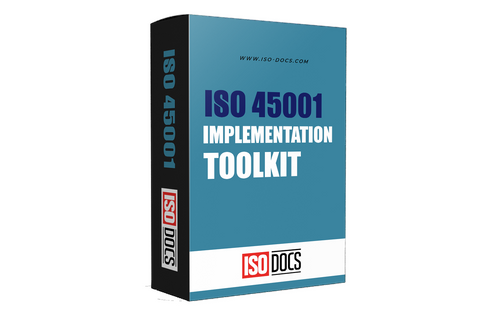ISO 45001 Gap Analysis Checklist Template
Introduction: Understanding ISO 45001 And The Importance Of Gap Analysis
ISO 45001 outlines the requirements for an effective occupational health and safety (OHS) management system. The goal of ISO 45001 is to enhance workplace safety in the organization from risks and hazards. Achieving compliance with ISO 45001 is crucial for any organization to ensure a safe work environment.One of the important steps is the process of conducting a gap analysis. This systematic approach allows one to distinguish between the current safety practice and requirements set forth by ISO 45001, understanding these differences, business can enhance their safety practice in their organizations.

Defining ISO 45001 And Its Significance In Occupational Health And Safety
ISO 45001 provides a framework for organizations to improve employee safety and reduce workplace hazards, and create a better work environment. By implementing these standards, companies can demonstrate their commitment to Occupational health and Safety, which can enhance their reputation and improve the visibility of safety.
The Concept Of A Gap Analysis And Its Role In Achieving ISO 45001 Compliance
The Gap Analysis is a useful tool that helps organization assess their current safety policies and practices against ISO 45001 requirements. This tool process involves identifying areas where existing practices fall short and determining the necessary steps to achieve compliance. By conducting a thorough gap analysis, an organization can prioritize its efforts and allocate resources effectively.
Benefits Of Conducting A Thorough Gap Analysis For Workplace Safety And Employee Well-Being
Performing a comprehensive gap analysis not only aids in achieving ISO 45001 compliance but also brings numerous benefits. It enhances the safety at the workplace by identifying actual causes/hazards and implementing effective controls. Furthermore, it extends to continuous improvements, which ensure employees’ safety remains a top priority. Ultimately, organizations that invest in analysing the gap can expect more improvements and enhanced employee morale, reduce health hazards, and lower the insurance premiums.
Step-by-Step ISO 45001 Gap Analysis Checklist: Key Areas To Assess
Regular conducting of gap analysis is essential for organizations aiming to align their occupational health and safety management system with Iso 45001 standards. This checklist will give you clear guidelines for critical areas to assess, ensuring safety practices.
1. Hazard Identification and Risk Assessment Procedures
Start by reviewing your ongoing methods for hazard identification and risk assessment against ISO 45001 requirements. This involves evaluating how risks are identified, assessed, and controlled within your organisation. Ensure that your processes are comprehensive and that they effectively mitigate potential hazards in workplaces.

2. Emergency Preparedness and Response Plans
Next, start evaluating the effectiveness of your emergency preparedness and response plans. These plans should align with ISO 45001 standards, ensuring that your organization is ready to respond to emergencies effectively. Get access to determine whether your current procedures are well-documented, communicated, and practiced through regular drills.
3. Internal Communication and Consultation
Internal Communication is vital for fostering a healthy culture of safety. Assess the channels through which safety information is shared and how employees are involved in safety matters. Engaging employees in discussions about their views on safety policies not only enhances compliance but also promotes a proactive approach to workplace safety.
4. Legal Compliance and Regulatory Requirements
Finally, verify that your organization adheres to the safety legislation. This includes understanding the legal requirements applicable to your industry and ensuring that your safety management practices meet these standards. Regular audits can help identify any gaps in compliance and facilitate necessary improvements.
Practical Tips For Conducting A Successful ISO 45001 Gap Analysis
Conducting a gap analysis for ISO 45001 is a crucial step in enhancing workplace safety and ensuring compliance with occupational and health standards. Below are the practical tips to guide you through the process effectively.
1. Involve Key Stakeholders from All Levels of the Organization
Engaging all levels of the organization is essential for a comprehensive gap analysis. This includes safety officers, management, and employees who are directly involved in daily operations. Their insight can provide valuable inputs on existing safety policies and practices, helping to identify potential hazards and areas for improvement.
2. Utilize a Combination of Document Review, Interviews, and On-Site Observations
A through gap analysis should showcase multiple methods of data collection. Start with document review to access current safety management systems and policies. Follow this with interviews to collect the data from employees about their experience and perceptions of workplace safety. Finally, conduct onsite observation to identify any discrepancies between documents, procedures, and actual practices.
3. Prioritize Identified Gaps Based on Their Potential Impact on Workplace Safety
Once gaps are identified, it is very important to prioritize them according to their potential impact on employee safety. Focus on those that pose a high risk to workers and the organization. This prioritization will help allocate resources effectively and ensure that the most critical issues are addressed as a first priority.
4. Develop a Clear Action Plan with Timelines and Responsibilities for Addressing Identified Gaps
A structure plan is vital for addressing the gaps identified during the analysis. This plan should outline the actions and responsibilities to team members and establish timelines for completion. By having a clear road map, your organization can systematically improve its safety management practices and ensure compliance with 45001 standards.
Conclusion
Once gaps have been identified, it is crucial for organizations to take active measures to address them. This may involve updating safety policies, providing additional training, or implementing new hazard identification processes. By actively working to close these gaps, companies can create a safer and healthier work environment for all employees, ultimately leading to improved morale and productivity.


